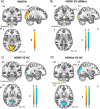Identification of discriminative neuroimaging markers for patients on hemodialysis with insomnia: a fractional amplitude of low frequency fluctuation-based machine learning analysis
- PMID: 36600230
- PMCID: PMC9811801
- DOI: 10.1186/s12888-022-04490-1
Identification of discriminative neuroimaging markers for patients on hemodialysis with insomnia: a fractional amplitude of low frequency fluctuation-based machine learning analysis
Abstract
Background and objective: Insomnia is one of the common problems encountered in the hemodialysis (HD) population, but the mechanisms remain unclear. we aimed to (1) detect the spontaneous brain activity pattern in HD patients with insomnia (HDWI) by using fractional fractional amplitude of low frequency fluctuation (fALFF) method and (2) further identify brain regions showing altered fALFF as neural markers to discriminate HDWI patients from those on hemodialysis but without insomnia (HDWoI) and healthy controls (HCs).
Method: We compared fALFF differences among HDWI subjects (28), HDWoI subjects (28) and HCs (28), and extracted altered fALFF features for the subsequent discriminative analysis. Then, we constructed a support vector machine (SVM) classifier to identify distinct neuroimaging markers for HDWI.
Results: Compared with HCs, both HDWI and HDWoI patients exhibited significantly decreased fALFF in the bilateral calcarine (CAL), right middle occipital gyrus (MOG), left precentral gyrus (PreCG), bilateral postcentral gyrus (PoCG) and bilateral temporal middle gyrus (TMG), whereas increased fALFF in the bilateral cerebellum and right insula. Conversely, increased fALFF in the bilateral CAL/right MOG and decreased fALFF in the right cerebellum was observed in HDWI patients when compared with HDWoI patients. Moreover, the SVM classification achieved a good performance [accuracy = 82.14%, area under the curve (AUC) = 0.8202], and the consensus brain regions with the highest contributions to classification were located in the right MOG and right cerebellum.
Conclusion: Our result highlights that HDWI patients had abnormal neural activities in the right MOG and right cerebellum, which might be potential neural markers for distinguishing HDWI patients from non-insomniacs, providing further support for the pathological mechanism of HDWI.
Keywords: Amplitude of low frequency fluctuation; Hemodialysis; Insomnia; Neural markers; Support vector machine (SVM).
© 2023. The Author(s).
Conflict of interest statement
All authors read and approved the final manuscript being given consideration for publication in “BMC Psychiatry”, and all authors declare that they have no competing interests.
The authors declare that they have no competing interests or other interests that might be perceived to influence the results and/or their interpretation as reported in this paper.
Figures





References
MeSH terms
LinkOut - more resources
Full Text Sources
Medical

